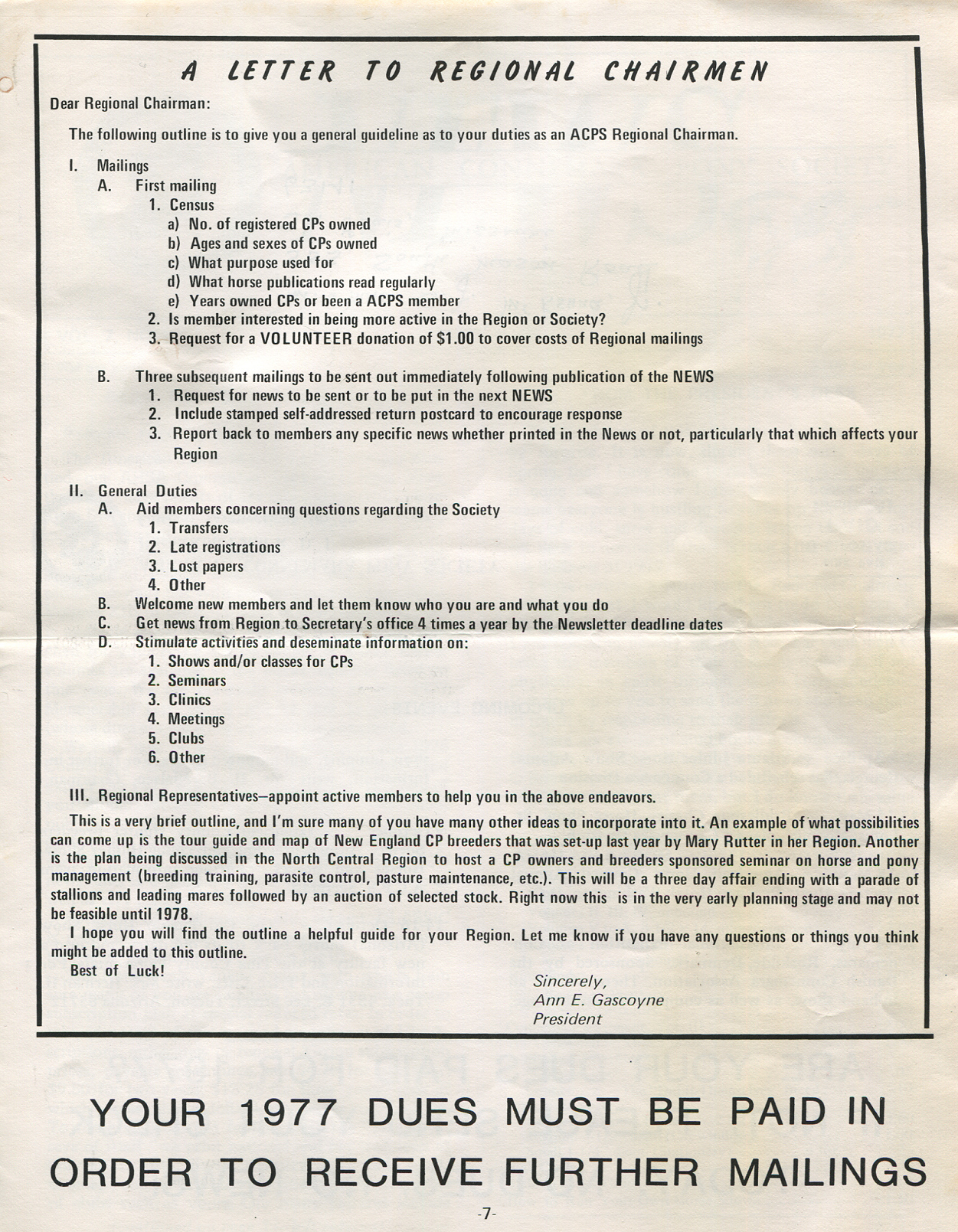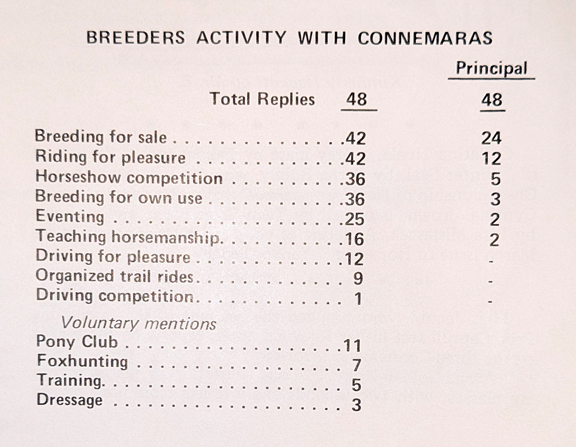1977 Spring Issue: ACPS Officials Prod Members to do More; Erin’s Shamrock Turns Heads
ACPS Secretary Betty O’Brien reported that the American Horse Shows Association had received the results of the first recognized Connemara Division under the Connemara’s new affiliation with the AHSA. She didn’t say which show sent the results.
O’Brien discussed several publications that might be of interest to members, including England’s Connemara Chronicle, which is published annually and includes news from societies around the world.
Ann Gascoyne’s letter to regional chairs
Ann Gascoyne, still ACPS president, reported that she had prepared a letter for regional chairs on how she wanted them to bring together Connemara owners in their area. She said it was up to the chairs to send members news and keep them in touch.

Gascoyne next took issue with few members buying the ACPS stud book, a conversation repeated from the previous newsletter. She said, “It is understandable that owning a complete set of ACPS stud books is not a No. 1 priority for many; however, it should be to every breeder, small and large. It tells who’s who and by whom and who else has produced what by whomever — important facts when selecting breeding stock or just a suitable Connemara for a specific task. To set up any sensible breeding plan, you need more than just a name out of the past. The stud books are full of statistics that can, when compiled, help plot out a plan for building a foundation herd and adding to it. The stud books not only show who has produced what, but how many foals are being produced annually and movement of stock as shown through the transfer records recorded in the stud books. If you have just one or two mares, or are contemplating going into breeding, you will do well to purchase and carefully study the ACPS stud books. If you are already a breeder, they are a must!”
And then she asked members to make sure Connemaras were registered and the society was made aware of horse owners calling an unregistered horse or pony a Connemara when it may not be one.
Gascoyne made one comment on this point that we disagree with, saying: “We must promote the idea that if it (a pony) is not registered, it is not a Connemara.”
Our comment would be that a Connemara that is genetically the offspring of two Connemaras is indeed a Connemara, no matter what papers it does or doesn’t have. While the ACPS exists to “assist” breeders, according to its own mission statement in the ACPS News, it’s just a society, not some Connemara god.
We love Gascoyne’s final comment: “While sitting here writing this message, I wonder how this is going to be taken. What is it that members are interested in? What is the mood of the members? How many actually read the News? Please let me hear from you answering these questions and giving suggestions and ideas of your own.”
She may have been the only ACPS president to actively solicit member feedback.
Ann Gascoyne’s background
Gascoyne was such a promoter of surveys and statistics in the ACPS News that we figured she had to be some sort of data analyst. We tracked down her obituary, and her day job actually was fashion illustrator. Didn’t see that coming.
We knew she had died young. She died at age 39 in 1985 at a hospital in Kentucky after a long illness, according to her obituary, which ran on July 25, 1985, in The Ridgewood News, a New Jersey newspaper, where her parents lived.
Her obituary said she married Ronald Wesley Gascoyne in 1971 and established Threesprings Farm in Crestwood, Kentucky.
She had worked briefly as an exercise person at the John Callaway Farm in Anchorage, Kentucky, where she broke to saddle and rode famed race horse John Henry.
She was the founder of the Louisville Dressage Society.
She also managed to be a parent to son James R. Gascoyne.
Her husband died young, too, at 58, of cancer in 1994. He was a famous architect in Louisville.
The obituary doesn’t say her stallion was Gilnocky Ard Righ MacDaire, but that seems an important point, so we’ll add it here.
So, she wasn’t a data analyst, just a super smart ACPS official who understood the need and value of having and publishing data on Connemaras and the ACPS.
Lack of members at meeting
The newsletter reported that the meeting of the board of governors in St. Louis in December 1976 did not have a quorum, so it was necessary to poll the board on actions initiated at the meeting. A few actions were listed and their votes.
All actions passed, including that the newsletter would report deaths, stallion registrations and transfers in each issue.
Results of question to breeders
One news item provided breeders’ answers to the question: “Which of these is your primary activity?” The answers were collected when the ACPS was putting together the Breeders Directory. The writer said these answers wouldn’t properly reflect all members. Thus, the ACPS was repeating the question for all newsletter readers and hoped everyone would reply, even the breeders who responded earlier. A card inserted into the newsletter was to be filled out and returned.
Breeders’ responses showed that the principal goal of half of those who answered, or 24 of 48 respondents, was to make money selling Connemaras.

Horse show news
The horse show news section started off by reprinting text from the January 1977 issue of the USCTA News. The time reference is unclear, but the publication likely was citing results from 1976.
The USCTA said the leading horse in Area 1 was Erin’s Shamrock (*Tooreen Laddie out of Erinbay, by Little Heaven), bred by Hideaway Farm.
The 15-hand gray Connemara gelding was described as exceedingly game with unusual speed for his breeding (we’re not surprised at all by his speed, given his breeding).
The USCTA said: “This year, he won Shepley Hill and Puckerbrush at the Intermediate level and won the Flying Horse 3-Day (Open Preliminary) and was second individually in the North American Junior Team Championships in Illinois. Shamrock is very athletic cross country, is quick on his feet and has the ability to jump at speed. He is also generally a high scorer in dressage.”
Shamrock was born in 1964. He was purchased by the Lendes as a 5-year-old in 1969.
On Shamrock’s rider, Karen Lende (now Karen O’Connor), the USCTA said she was “another rider who has come up through the ranks of Pony Club and has her “A” rating. She has competed on Erin’s Shamrock for the past six years since buying him as an almost unbroken 5-year-old.”
Unfortunately, there’s no photo accompanying the text.
Other noteworthy horse show news included that Kimberly Hackett of Dunwoody, Georgia, and her Connemara, Mr. B, won the Georgia Hunter Jumper Association Pony Medal in 1976.
Cybatina Nuala (Ballyconneely Fergus out of *Winter Seal, by Carna Bobby) won the Large Pony Hunter Championship of New Hampshire.
Avens Golden Ruby (by *Ruta Raitni out of *Ciatog, by Doon Paddy) placed first in six classes and won a halter class, as well, at an all-breed show, according to owner Doris Jacobi, of Alberta, Canada.
Other ponies performing well included Mount View Paddy and Learg Dawn.
Deaths
Deaths included stallion *Hyndon Slipper, born in 1963, by Hyndon Prince Finbarr out of Hyndon Sealin, by Gael Linn.
Bred in England, he was imported to the US by Mrs. John T. Jones Jr. and stood at Brazos Connemara Farm in Hempstead, Texas. He produced two foals in the US.
Also deceased was mare *Cregs Southern Bell, born in 1958, by Creg Coneera out of Noreen, by Heather Bell.
She was imported by Robert H. Wright Jr., purchased by Dorothy Lyons and then owned by Mrs. E. R. Helmer of Hemet, California. She was put down due to melanomas.
Lastly, mare *Belle of Rosmuck also died. Born in 1957, she was by Tully Lad out of Dun Belle, by Heather Bell.
Belle spent the last half of her life in Connecticut and was owned by Miss Robin Sweeney of Goshen.
She was described as the epitome of a good performance Connemara. She also had one filly, Baybelle, in 1968, by Whitewood Galway Bay.
Gallery
Click a photo to enlarge it.

